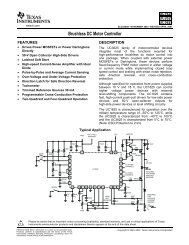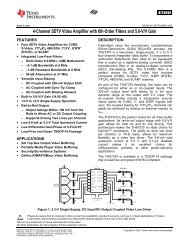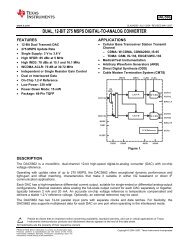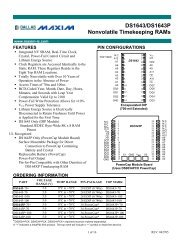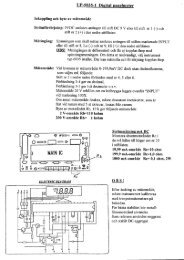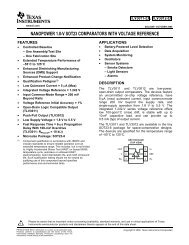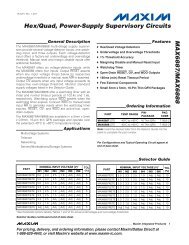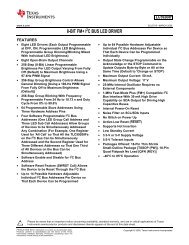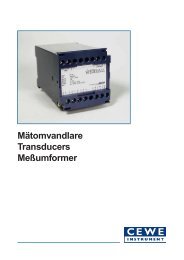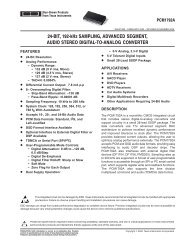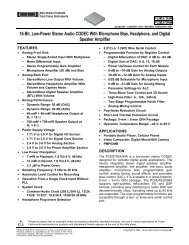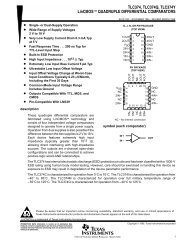Single-Chip Low Power RF Transceiver for Narrowband Systems ...
Single-Chip Low Power RF Transceiver for Narrowband Systems ...
Single-Chip Low Power RF Transceiver for Narrowband Systems ...
Create successful ePaper yourself
Turn your PDF publications into a flip-book with our unique Google optimized e-Paper software.
frequencies is done through the MAIN<br />
register. Several fe atures have been<br />
included to do the hopping without a need<br />
to re-synchron ize the receiver. For more<br />
details refer to Application Note AN014<br />
Frequency Hopping <strong>Systems</strong> available<br />
from the <strong>Chip</strong>con web site.<br />
In order to implement a frequency hopping<br />
system with CC1021 do the following:<br />
Set the desired frequency, calibrate and<br />
store the following register settings in nonvolatile<br />
memory:<br />
S TATUS1[3:0] : CHP_CURRENT[3:0] S TATUS2[4:0] : VC O_ARRAY[4:0]<br />
STATUS3[5:0]:VCO_CAL_CURRENT[5:0]<br />
Repeat the calibration <strong>for</strong> each desired frequency. VCO_CAL_CURRENT[5:0] is<br />
not dependent on the <strong>RF</strong> frequency and<br />
the same value can be used <strong>for</strong> all<br />
frequencies. When<br />
per<strong>for</strong>ming frequency<br />
h opping, write the stored values<br />
to the<br />
corresponding TEST1, TEST2 and TEST3<br />
registers, and e nable override:<br />
TEST1[3:0]: CHP_CO[3:0]<br />
TEST2[4:0]: VCO_AO[4:0] TEST2[5]: VCO_OVERRIDE<br />
TEST2[6]: CHP_OVERRIDE 24. PCB Layout Recommendations<br />
The<br />
top layer should be used <strong>for</strong> signal<br />
routing, and the open<br />
areas should be<br />
filled with metallization connected to<br />
ground using<br />
several vias.<br />
The area under the chip is used <strong>for</strong><br />
grounding and must be connecte d to the<br />
bottom ground plane with several v ias. In<br />
the <strong>Chip</strong>con reference designs we have<br />
placed 9 vias in side the exposed die<br />
attached p ad. These vias should be<br />
“tented” (covered with solder mask) on the<br />
component side of the PCB to avoid<br />
migration<br />
of solder through the vias during<br />
the solder reflow process.<br />
Each decoupling capacitor should be<br />
placed as close as possible to the supply<br />
pin<br />
it is supposed to decouple. Each<br />
decoupling capacitor should be connected<br />
to the power line (or power plane) by<br />
separate vias. The best routing is from the<br />
TEST3[5:0]: VCO_CO[5:0]<br />
TEST3[6]: VCO_CAL_OVERRIDE<br />
CC1021<br />
CHP_CO[3:0]<br />
is the register setting read<br />
from<br />
CHP_CURRENT[3:0], VCO_AO[4:0]<br />
is the register setting read from<br />
VCO_ARRAY[4:0] and VCO_CO[5:0] is<br />
the<br />
register setting read from<br />
VCO_CAL_CURRENT[5:0].<br />
Assume<br />
channel 1 defined by register<br />
FREQ_A is currently<br />
being used and that<br />
CC1021<br />
should operate on channel 2 next<br />
( to change channel simply write to register<br />
MAIN[6]).<br />
The channel 2 frequency can be<br />
set<br />
by register FREQ_B which can be<br />
written<br />
to while operating on channel 1.<br />
The calibration data<br />
must be written to the<br />
TEST1-3 registers after switching to the<br />
n ext frequency. That is, when hopping to a<br />
new channel write to register MAIN[6] first<br />
and the test registers next. The PA should<br />
b e switched off between each hop and the<br />
PLL<br />
should be checked <strong>for</strong> lock be<strong>for</strong>e<br />
switching the PA back on after a hop has<br />
been<br />
per<strong>for</strong>med.<br />
Note that the override bits<br />
VCO_OVERRIDE,<br />
CHP_OVERRIDE and<br />
VCO_CAL_OVERRIDE<br />
must be disabled<br />
when<br />
per<strong>for</strong>ming a re-calibration.<br />
power line (or power plane) to the<br />
decoupling capacitor and then to the<br />
CC1021 supply pin.<br />
Supply power filtering<br />
is very important, especially<br />
<strong>for</strong> pins 23,<br />
22 , 20 and 18.<br />
Each decoupling capacitor ground pad<br />
sho uld be connected to the ground plane<br />
using a separate via.<br />
Direct connections<br />
between neighboring power pins will<br />
increase noise coupling and should be<br />
avoided unless absolutely necessary.<br />
The external components should ideally<br />
be as small as possible and surface mount<br />
devices are highly recommended.<br />
Precaution should be used when placing<br />
the microcontroller in order to avoid noise<br />
interfering with the <strong>RF</strong> circuitry.<br />
The recommended CC1021 PCB layout is<br />
the same as <strong>for</strong> the CC1020. A<br />
SWRS045B Page 63 of 89



